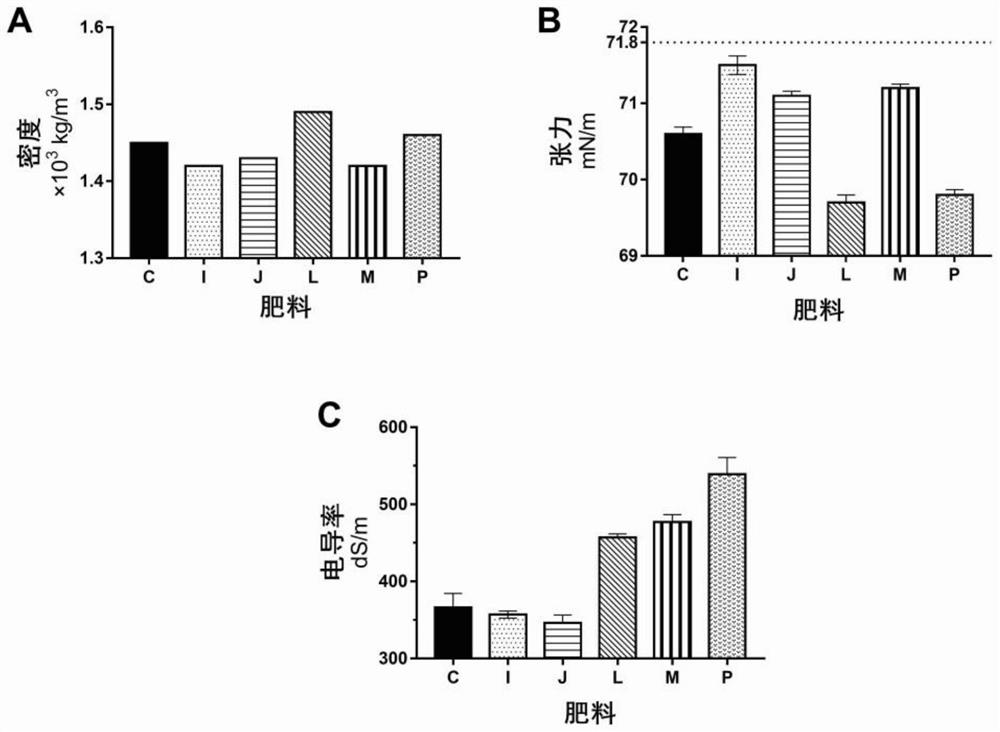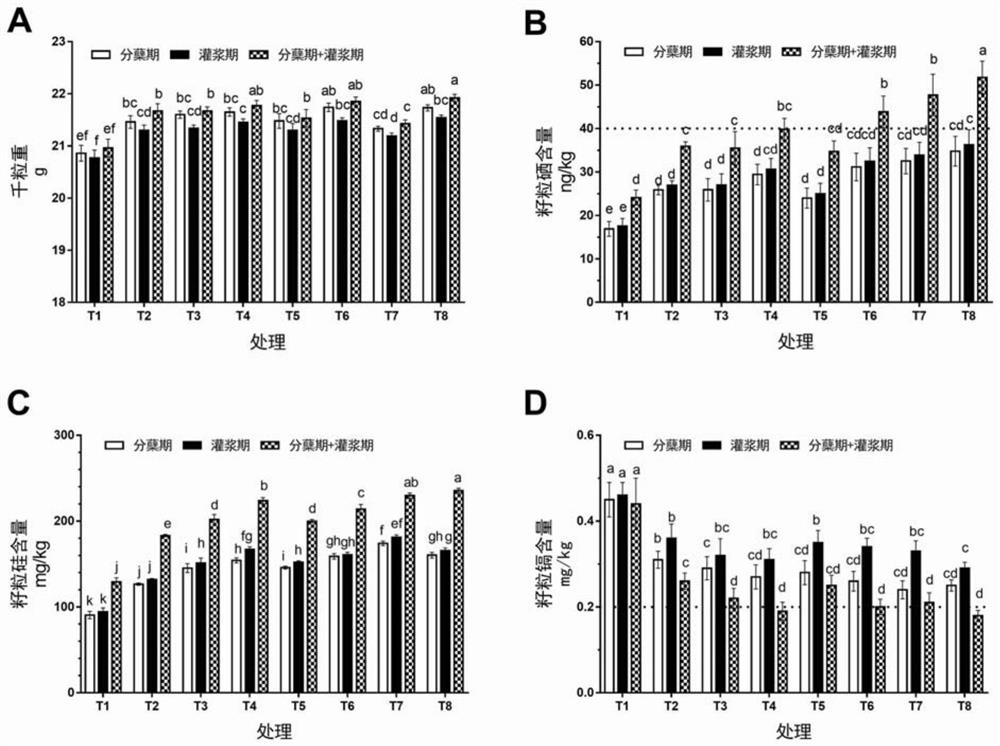Carbon-based seaweed silicon-selenium suspended fertilizer, preparation method thereof and application of carbon-based seaweed silicon-selenium suspended fertilizer in selenium enrichment and cadmium reduction of rice
A technology of carbon-based seaweed and seaweed silicon, which is applied in the fields of application, rice cultivation, liquid fertilizer, etc., can solve the problems of single nutrient composition, influence on fertilizer efficiency, and lack of ingredients, etc., to reduce plant cadmium absorption, reduce rice cadmium absorption, use method simple effect
- Summary
- Abstract
- Description
- Claims
- Application Information
AI Technical Summary
Problems solved by technology
Method used
Image
Examples
Embodiment 1
[0048] Embodiment 1: Preparation of different carbon-based seaweed silicon selenium suspensions
[0049] Suspending agent 1 is prepared by the following steps:
[0050] (1) Add 10kg of kaolin, 2.5kg of trimeric gulose-mannose-gulose and 2.5kg of tetrameric mannose into 238L of secondary water in sequence, and fully stir and dissolve at 50-60°C to obtain seaweed carbon base crosslinker solution.
[0051] (2) Dissolve 52.93L 100g / L Na at 25-35°C 2 SeO 3 (Sodium selenite) solution is mixed with 52.93L 0.1mol / L riboflavin, and add 40.31kg K 3 [Fe(CN) 6 ] (potassium ferricyanide).
[0052] (3) Add 211.72L 5.89mol / L H at 45-55°C 2 SiO 3 (Silicic acid) solution and an appropriate amount of 4.81mol / L ammonia mixture solution, so that the total mass of the silicon-selenium sol after fully stirring and mixing is 900kg, and the silicon-selenide sol is obtained.
[0053] (4) Add the seaweed carbon-based cross-linking agent solution prepared in step (1) to the silicon-selenium sol ...
Embodiment 2
[0109] Embodiment 2: Preparation of different carbon-based seaweed silicon selenium suspension fertilizers
[0110] According to the results of Example 1, select a stable and representative suspending agent solution for the next step of fertilizer preparation.
[0111] Suspension compound fertilizer A: mix 900kg suspending agent 1 with 87.5kg KH 2 PO 4 , 87.5kg NH 4 h 2 PO 4 Fully stir evenly under the condition of 50-60°C.
[0112] Suspension Compound Fertilizer B: Mix 900kg of Suspending Agent 3 with 87.5kg of KH 2 PO 4 , 87.5kg NH 4 h 2 PO 4 Fully stir evenly under the condition of 50-60°C.
[0113] Suspension compound fertilizer C: mix 900kg suspending agent 4 with 87.5kg KH 2 PO 4 , 87.5kg NH 4 h 2 PO 4 Fully stir evenly under the condition of 50-60°C.
[0114]Suspension Compound Fertilizer D: Mix 900kg Suspended Agent 5 with 87.5kg KH 2 PO 4 , 87.5kg NH 4 h 2 PO 4 Fully stir evenly under the condition of 50-60°C.
[0115] Suspension Compound Fertili...
Embodiment 3
[0134] Embodiment 3: Potted rice leaf spray test
[0135] This experiment was carried out in the network room of the College of Resources and Environment, South China Agricultural University, Guangzhou City, Guangdong Province in January 2019. The soil properties used in the test are as follows: organic matter 26.97g / kg, total nitrogen 1.18g / kg, total phosphorus 0.57g / kg, total potassium 11.18g / kg, total cadmium 2.41mg / kg, alkaline nitrogen 92.14mg / kg, available Phosphorus 32mg / kg, available potassium 112.23mg / kg, available cadmium 1.16mg / kg, pH 5.45. The tested rice variety is Tianyou 998 (Yueshendao 2004008). The seeds were soaked in clear water at 35°C for 2 days, and then cultured for 1 day after accelerated germination. After cultivating for about 30 days, transplant them into plastic pots, and fill each pot with 10kg of soil. Each treatment was repeated in 3 pots, with 3 clumps in each pot and 3 plants in each clump. The experiment set up 8 treatments:
[0136] T1, c...
PUM
 Login to View More
Login to View More Abstract
Description
Claims
Application Information
 Login to View More
Login to View More - R&D
- Intellectual Property
- Life Sciences
- Materials
- Tech Scout
- Unparalleled Data Quality
- Higher Quality Content
- 60% Fewer Hallucinations
Browse by: Latest US Patents, China's latest patents, Technical Efficacy Thesaurus, Application Domain, Technology Topic, Popular Technical Reports.
© 2025 PatSnap. All rights reserved.Legal|Privacy policy|Modern Slavery Act Transparency Statement|Sitemap|About US| Contact US: help@patsnap.com



